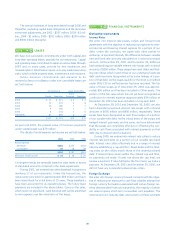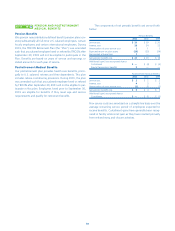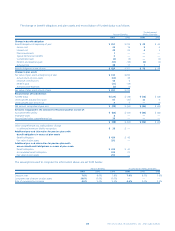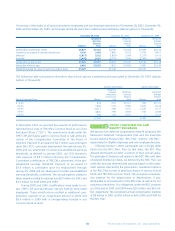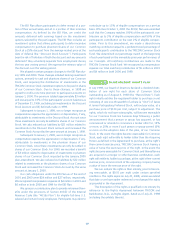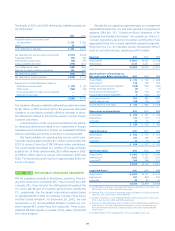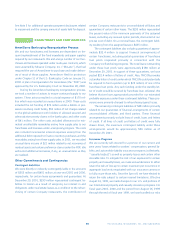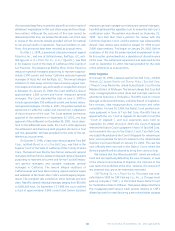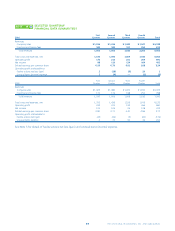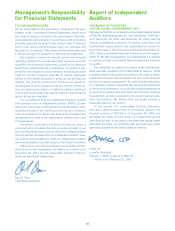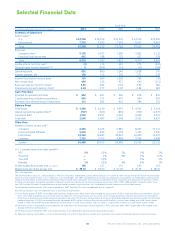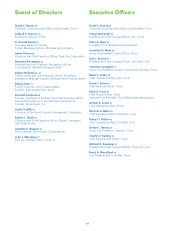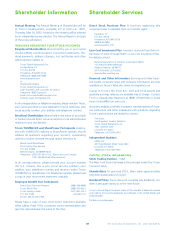Pizza Hut 2001 Annual Report Download - page 63
Download and view the complete annual report
Please find page 63 of the 2001 Pizza Hut annual report below. You can navigate through the pages in the report by either clicking on the pages listed below, or by using the keyword search tool below to find specific information within the annual report.61
for casualty losses, property losses and various other insurable
risks into one pool with a single self-insured retention and have
purchased reinsurance coverage up to a specified limit which is
significantly above our actuarially determined probable losses.
We are self-insured for losses in excess of the reinsurance limit.
We believe the likelihood of losses exceeding the reinsurance
limit is remote. We are also self-insured for healthcare claims for
eligible participating employees subject to certain deductibles
and limitations. We have accounted for our retained liabilities
for property and casualty losses and healthcare claims, includ-
ing reported and incurred but not reported claims, based on
information provided by our independent actuaries.
Due to the inherent volatility of our property and actuari-
ally determined casualty loss estimates, it is reasonably possible
that we could experience changes in estimated losses which
could be material to our growth in quarterly and annual net
income. We believe that we have recorded our reserves for
property and casualty losses at a level which has substantially
mitigated the potential negative impact of adverse develop-
ments and/or volatility.
Change of Control Severance Agreements
In September 2000, the Compensation Committee of the Board
of Directors approved renewing severance agreements with cer-
tain key executives (the “Agreements”) that were set to expire
on December 31, 2000. These Agreements are triggered by a
termination, under certain conditions, of the executive’s employ-
ment following a change in control of the Company, as defined
in the Agreements. If triggered, the affected executives would
generally receive twice the amount of both their annual base
salary and their annual incentive in a lump sum, outplacement
services and a tax gross-up for any excise taxes. These
Agreements have a three-year term and automatically renew
each January 1 for another three-year term unless the Company
elects not to renew the Agreements. Since the timing of any
payments under these Agreements cannot be anticipated, the
amounts are not estimable. However, these payments, if made,
could be substantial. In the event of a change of control, rabbi
trusts would be established and used to provide payouts under
existing deferred and incentive compensation plans.
Wage and Hour Litigation
We are subject to various claims and contingencies related to
lawsuits, taxes, environmental and other matters arising out of
the normal course of business. Like certain other large retail
employers, Pizza Hut and Taco Bell have been faced in certain states
with allegations of purported class-wide wage and hour violations.
On August 29, 1997, a class action lawsuit against Taco Bell
Corp., entitled Bravo, et al. v.Taco Bell Corp. (“Bravo”), was filed
in the Circuit Court of the State of Oregon of the County of
Multnomah. The lawsuit was filed by two former Taco Bell shift
managers purporting to represent approximately 17,000 current
and former hourly employees statewide. The lawsuit alleges vio-
lations of state wage and hour laws, principally involving unpaid
wages including overtime, and rest and meal period violations,
and seeks an unspecified amount in damages. Under Oregon
class action procedures, Taco Bell was allowed an opportunity
to “cure” the unpaid wage and hour allegations by opening a
claims process to all putative class members prior to certifica-
tion of the class. In this cure process, Taco Bell has paid out less
than $1 million. On January 26, 1999, the Court certified a class
of all current and former shift managers and crew members
who claim one or more of the alleged violations. A trial date
of November 2, 1999 was set. However, on November 1, 1999,
the Court issued a proposed order postponing the trial and
establishing a pre-trial claims process. The final order regarding
the claims process was entered on January 14, 2000. Taco Bell
moved for certification of an immediate appeal of the Court-
ordered claims process and requested a stay of the proceedings.
This motion was denied on February 8, 2000. Taco Bell appealed
this decision to the Supreme Court of Oregon and the Court
denied Taco Bell’s Writ of Mandamus on March 21, 2000. A
Court-approved notice and claim form was mailed to approxi-
mately 14,500 class members on January 31, 2000. The Court
ordered pre-trial claims process went forward, and hearings to
determine potential damages were held for claimants employed
or previously employed in four selected Taco Bell units. After the
initial hearings relating to these four units, the damage claims
hearings were discontinued. Trial began on January 4, 2001. On
March 9, 2001, the jury reached verdicts on the substantive
issues in this matter. A number of these verdicts were in favor
of the Taco Bell position; however, certain issues were decided
in favor of the plaintiffs. The Court reduced the number of
potential claimants to 1,100. A jury trial to determine the dam-
ages of 93 of those claimants began on February 25, 2002, and
is expected to last six to eight weeks.
We have provided for the estimated costs of the Bravo lit-
igation, based on a projection of eligible claims (including claims
filed to date, where applicable), the cost of each eligible claim,


